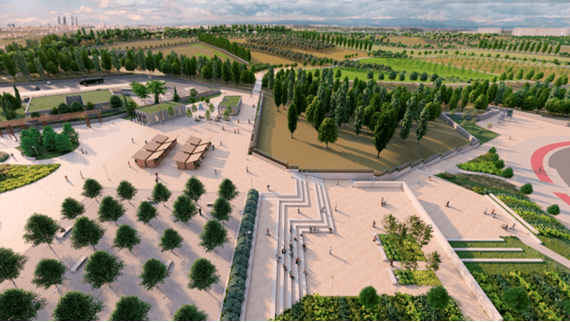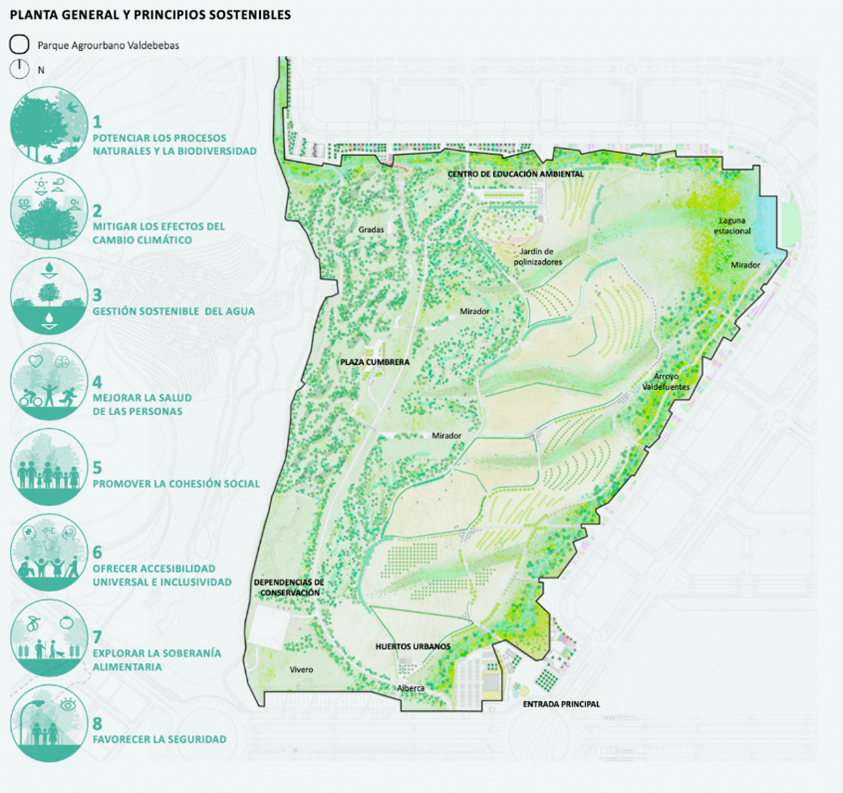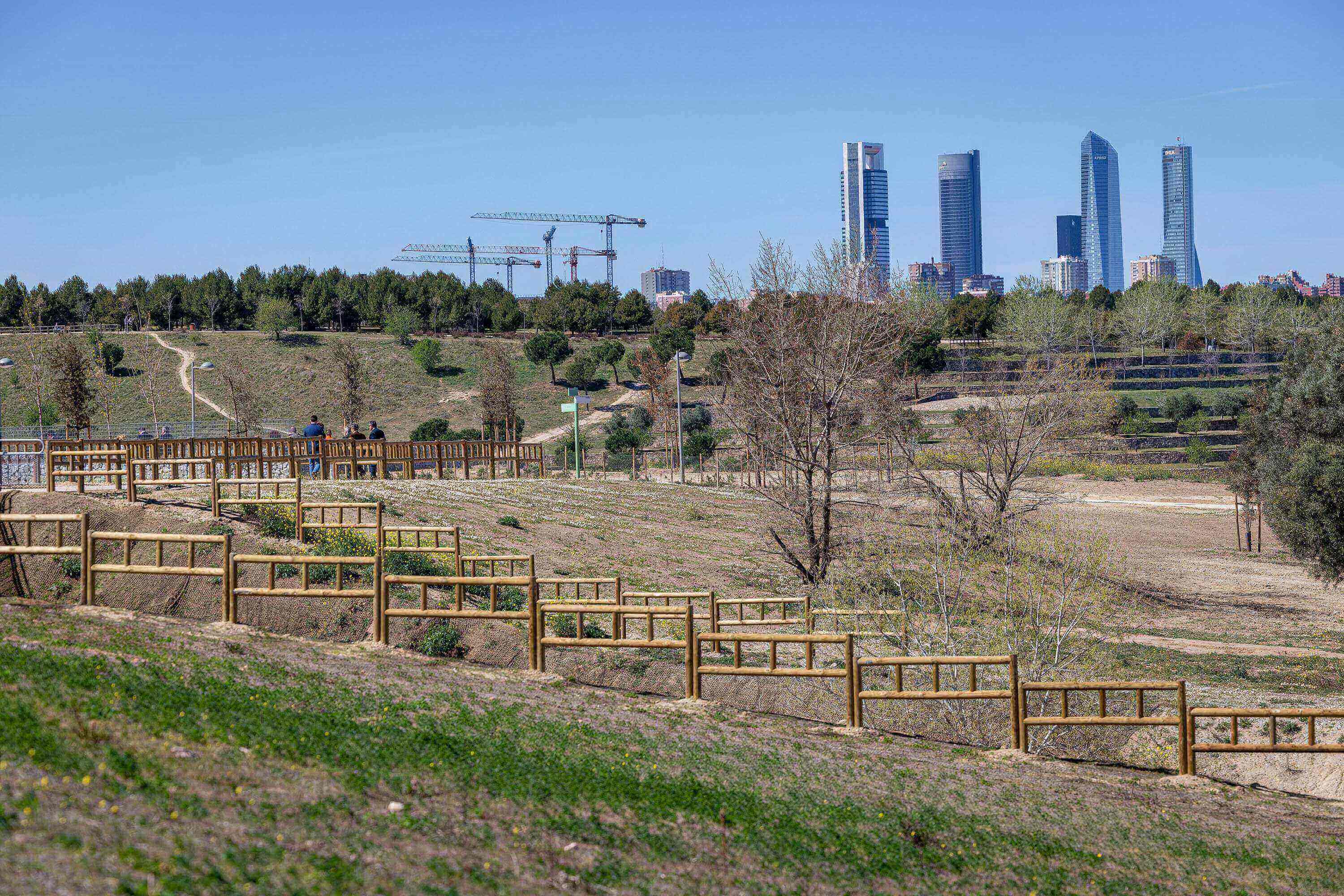With the aim of recovering the landscape richness of the area, the Compensation Board of Valdebebas, together with Sacyr Engineering and Infrastructure, launched a restoration project that would bring the rural world closer to the urban population.
The proposal consisted of recovering natural processes and ecosystem services, responding to the specific conditions of the site, and promoting biological and cultural diversity, through Nature-Based Solutions.
The main restoration objectives of the project were:
1. Enhance natural processes and biodiversity: through the restoration of the landscape with native plant communities, maintenance needs are reduced, and the presence of wild fauna is encouraged.
2. Mitigate the effects of climate change: thanks to the increase in vegetation cover, the management of extreme weather events is improved, and the heat island effect from urbanization is reduced, creating a significant carbon sink.
3. Sustainable water management: efficient use of water cycles was one of the most important objectives of the project, where the aim was to restore the hydrological function and use rainwater and surface drainage for plantations.
4. Improve people's health: with this goal, the aim was to create a green space for people to enjoy and connect with nature.
5. Promote social cohesion: through an environmental education center that would seek to involve citizens, with a special focus on children.
6. Offer universal accessibility and inclusiveness: this natural environment was designed with the idea that all people could enjoy the space.
7. Explore food sovereignty: by creating urban community gardens, the aim is to encourage users to grow vegetables and develop educational activities related to agroecological cultivation, healthy eating habits, and circular economy.
8. Safety: with the aim of designing a safe space, visibility was taken into account in all routes, as well as additional measures to avoid an overall feeling of insecurity.

Once the project objectives were defined, different actions were taken:
• Measures for the recovery of dry channels. According to these measures, water passage areas were created, and the Valdefuentes stream bed areas were adapted, according to the indications of the Tajo River Basin Authority. In addition, native species were planted to adapt to the low rainfall in the area. A lake was created as a prominent feature of the park with its seasonal variety.
• Plan for erosion and sedimentation control. This plan included definitive and provisional measures to prevent erosion. Within the definitive measures, the areas of the land where the water had a higher velocity were identified; different types of hydroseeding and plantations were located, and different gram weights of coconut networks were used. In addition, a series of provisional measures were defined with the aim of preventing erosion processes, such as barriers with geotextiles, placement of wooden stakes, periodic measurements, etc.
• Restoration of vegetation cover. A study of the park's vegetation layer was carried out to analyze the existence of microorganisms, with the aim of recreating and reproducing microscopic life on new surfaces through hydroseeding and plantations. It was concluded that the soil was very poor and that biofertilizers had to be used as a preliminary step to hydroseeding and plantations.
• Plantations. The plant communities found in this park are indigenous, highlighting the holm oak (Quercus ilex subs. ballota), cork oak (Quercus suber), common oak (Quercus faginea), and Pyrenean oak (Quercus pyrenaica). Groups of stone pine (Pinus pinea) and Aleppo pine (Pinus halepensis) were also incorporated to quickly increase shaded areas and enhance biodiversity.
• Invasive species. In the inventory of existing trees, invasive species such as the tree of heaven (Ailanthus altissima) and the introduced Siberian elm (Ulmus pumila), which is currently considered a problematic species close to being invasive, were identified and removed at the beginning of the project.
The park restoration project has met the requirements for soil regeneration, waterways, indigenous flora, and increased wildlife presence.

Currently, the project is in the process of obtaining the SITES certification from the Green Business Certification Inc., certifying the integration of sustainability goals in all phases of the project, and being one of the first projects certified under this standard in Europe.
The restoration project is monitored by the construction management team of Evergreen Paisajismo-GIS ingeniería.
With the implementation of projects like the restoration of this park, Sacyr aims to build resilient, accessible, diverse, green, and safe cities of the future, always serving the people who enjoy them.
